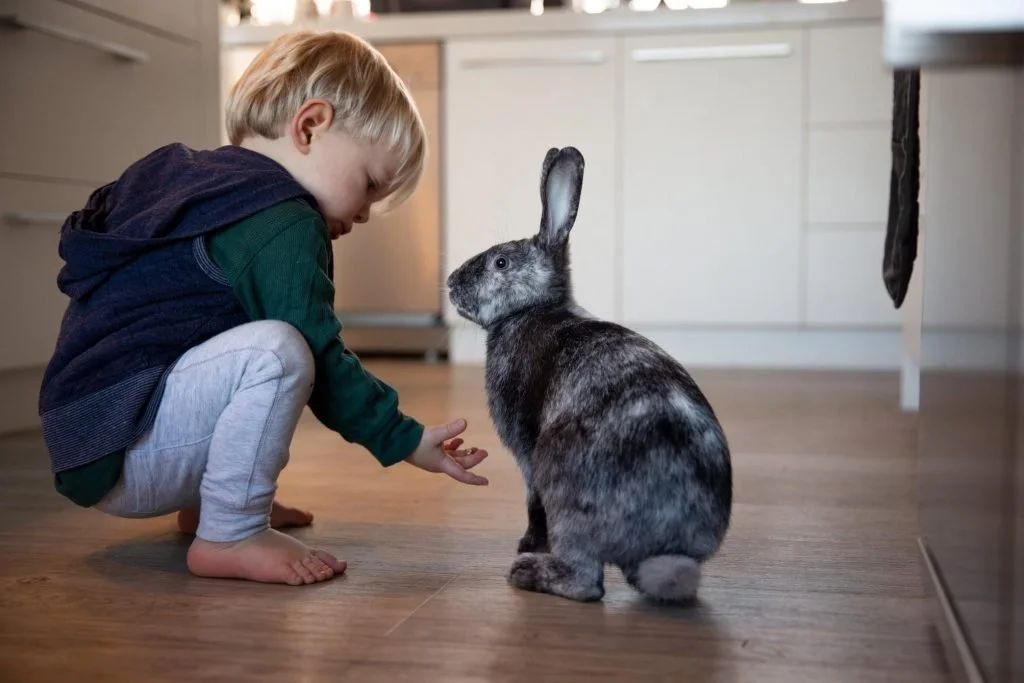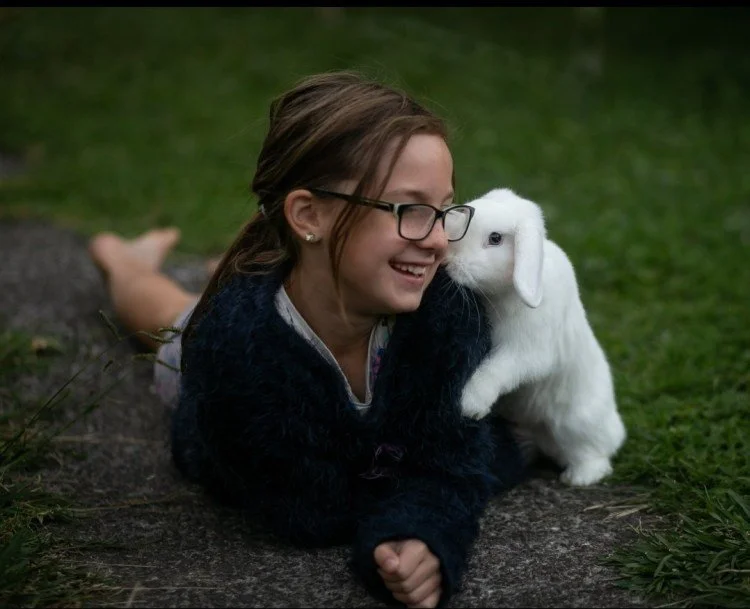Rabbits & Children
“It is not easy to manage young humans and animals, but when parents find solutions, rather than dispose of an animal for convenience’s sake, an important concept is communicated to the child. This is alive. This is valuable. You don’t throw it away.” –Marinell Harriman
Our goal is to foster safe, happy, calm and beneficial interaction between your rabbit and your child.
To this end …
Educate yourself about rabbit behaviour/language so you understand your rabbit’s feelings when interacting with your child/children.
Use your child’s ‘quiet time’ to initiate supervised interaction between your child and your rabbit.
Lead by example – show your child the best and safest ways to interact with your rabbit.
Foster and focus on positive interactions between your child and your rabbit. Supervise carefully so that you can reward gentle, appropriate behaviour instead of correcting negative, rough handling etc. If the child will not listen/follow direction then remove them from the rabbit so that any ‘acting out’ will not harm or distress the rabbit.
Set up your rabbit’s housing so it has a safe zone where it can get away from unwanted attention. For house rabbits use measures such as child gates in doorways to restrict access to the rabbit’s area.
Give your rabbit a chance to settle in before introducing it to friends and extended family.
If your child has friends over do not allow a group/crowd to overwhelm the rabbit. Instead, one or two at a time, show your child’s friends where the rabbit lives and how to pet gently and safely, always respecting the rabbit’s boundaries.
Our Goal …
… is to foster safe, happy, calm and beneficial interaction between your rabbit and your child.
What You Can Do With Different Ages
Sitting/Crawling Infants (6-12 months)
Start teaching the idea that the rabbit is to be respected and treated carefully.
Bunny Rule Number 1: Gentle Petting. Sit on the floor with the child in your lap while you pet and talk to the rabbit. Guide her hand over the rabbit’s head, ears, and upper back. To prevent fur-grabbing, hold her hand flat or use the back of her hand. Do this frequently but no longer than 5 minutes at a time.
Bunny Rule Number 2: Leave the rabbit alone when he hops away or goes in his cage. Interpret the rabbit’s body language for the child -
“Oops, he didn’t want any more petting. He wants to eat or take a nap.” Prevent the tendencies to chase a rabbit who has had enough and to bang/poke on the cage by explaining that “Chasing him will make him scared of you,” or “Banging on his house scares him.” Watch your child carefully and make such explanations at the moment before it looks like the child may engage in such behaviours. Explaining then redirecting the child’s attention works best for this age when inappropriate behaviour seems imminent or occurs.
Toddlers (1-2 years)
Continue reinforcing or teach Bunny Rules 1 & 2 and add Number 3. Although unintentional, toddlers are capable of doing real harm to a rabbit. They will need constant supervision and frequent, gentle reminders of appropriate behaviour.
Bunny Rule Number 1: Gentle Petting - Due to still-developing muscle coordination, toddlers have a hard time keeping fingers out of rabbits’ eyes, so you may have to insist on two-finger petting or back-of-hand petting.
Bunny Rule Number 2: Leave the rabbit alone when he hops away or goes in his cage. Closely supervise children’s interactions with the rabbit. This is the “age of the stick” when some are prone to bash things with sticks. Children this age also have a hard time not chasing a rabbit who hops away. If she chases the rabbit, the rabbit will learn to be scared of her. Teach respect for the rabbit ending the petting or playing session–”Well, that’s all he wanted to do”–and interest the child in another activity.
Bunny Rule Number 3: We pet, but don’t pick up the rabbit. Explain that “it scares the rabbit to be picked up and both of you could get hurt.” Explain that Mom or Dad may pick up the rabbit if she needs care.
Explain rabbit language and actions: “Hear her teeth clicking? She likes petting”. “See her toss the ball? She’s playing.” If the child gets scratched, explain what the child did to scare or hurt the rabbit and show her a better way to act. Redirect loud play to another area – ”Look at the bunny. She doesn’t like the noise.”
Toddlers love to share their snacks with the rabbit so make sure rabbits gets only small amounts proper foods and is not overloaded with cereals and crackers. They also love to help with feeding–scooping and pouring food, taking vegetables and hay to the rabbit.
Two-to Seven-Year Olds
If a 2 year old has grown up with the rabbit, she can have quite a bit of empathy for and knowledge about a rabbit. Continue or teach Bunny Rules Numbers 1 through 3. Teach by example instead of by a lot of “No’s,” your child will learn most by watching you. If interested, the child may help with feeding and play with the rabbit with your supervision.
Older Children
Continue or teach Bunny Rules Numbers 1 through 3. Teach by example and setting up situations for success. Your child may build a friendship with the rabbit by sitting on the floor with the rabbit while doing homework, art work, reading, or watching television. The rabbit will eventually come to investigate and to be petted. Older children have lots of other interests and interest in the rabbit may come and go. The rabbit’s care should continue to be your responsibility, but your child may help with feeding and grooming.
Teaching Responsibility – Something to Think About
Many parents say they want to get a rabbit for their child to teach the child some responsibility. What usually happens is that the child loses interest (not to mention being incapable of sticking to a routine and providing proper care), and the rabbit suffers. The child, at best, learns to feel bad that she has failed and caused suffering. At worst, she learns to resent the animal for the nagging that she is hearing from the adult. Often, the rabbit is given away because “you didn’t take care of it.” The child learns that life is disposable and that is she waits long enough, someone else will relieve her of her “responsibility.”
So let your child help with the rabbit, but don’t insist. If the child appears interested, encourage her; if she becomes bored, let her move on to the next thing, and you carry on with the rabbit. She learns most of all from watching you–your actions, your tone of voice when you speak to the rabbit, and your attitude. From this she learns the nurturing (responsible) point of view–the patient waiting, the faithful caring, the joyful appreciation and acceptance of a living creature for who it is, not who you wish it to be.
Material based - with edits, on an article by The House Rabbit Resource Network.


